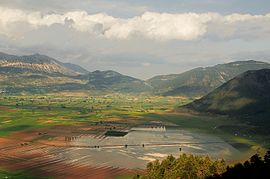Feneos
Feneos
Φενεός | |
|---|---|
Settlement | |
 Feneos plain showing seasonal floods. | |
| Coordinates: 37°57′N 22°19′E / 37.950°N 22.317°E | |
| Country | Greece |
| Administrative region | Peloponnese |
| Regional unit | Corinthia |
| Municipality | Sikyona |
| Area | |
| • Municipal unit | 226.2 km2 (87.3 sq mi) |
| Population (2011)[1] | |
| • Municipal unit | 1,342 |
| • Municipal unit density | 5.9/km2 (15/sq mi) |
| • Community | 87 |
| Time zone | UTC+2 (EET) |
| • Summer (DST) | UTC+3 (EEST) |
| Vehicle registration | ΚΡ |
Feneos (Greek: Φενεός, Latin: Pheneus) is a village and a former municipality in Corinthia, Peloponnese, Greece. Since the 2011 local government reform it is part of the municipality Sikyona, of which it is a municipal unit.[2] The municipal unit has an area of 226.201 km2.[3] Its population was 1,342 in 2011. The seat of the municipality was in Goura.
In ancient times the area was considered part of the Arcadian region. According to Herodotus the river Styx originates near Feneos.[4] Feneos lies at the foot of Mount Cyllene, mythical birthplace of the god Hermes. It therefore served as an important cult centre for the god, notably during the annual festival of the Hermaea.[5] Catullus (Poem 68) mentions the seasonal flooding of the plain and says it was drained by an underground channel dug by Hercules during his Twelve Labors
In the Aeneid, Evander's fond memories of a visit by Aeneas' father Anchises to Feneos are one factor in his decision to ally his Arcadian colonists to the Trojans.[6]
References
- ^ "Απογραφή Πληθυσμού - Κατοικιών 2011. ΜΟΝΙΜΟΣ Πληθυσμός" (in Greek). Hellenic Statistical Authority.
- ^ Kallikratis law Greece Ministry of Interior Template:El icon
- ^ "Population & housing census 2001 (incl. area and average elevation)" (PDF) (in Greek). National Statistical Service of Greece. Archived from the original (PDF) on 2015-09-21.
{{cite web}}: Unknown parameter|deadurl=ignored (|url-status=suggested) (help) - ^ Herodotus, Histories 6. 74. 1, http://www.theoi.com/Khthonios/PotamosStyx.html
- ^ Pausanias (2nd century CE. Description of Greece. VIII: 14: 10.
- ^ P. Vergilius Maro (29-19 BCE). Aeneis. VIII: 164.


